Thursday, February 26, 2009
Declaration
Native Americans and Native American art and culture are the concept I have chosen to complete my concept-folio. I have always been interested in learning about past American encounters with Native Americans, as well as the culture of various tribes. Through looking at different forms of art, I would like to be able to see different perceptions of specific Native American public figures, events, and ways of life. For example, paintings or photographs of religious rituals would be something very interesting to look at for the simple fact that it is a way to explore a religion different than my own, broadening my current knowledge. Essentially, I would like to expand my knowledge of Native Americans through looking specifically at works of art of and by Native Americans, using my resources to get background information which I would incorporate into my writings. Many Americans do not know much about Native Americans, and their knowledge is limited to what they learn in history class if they do not further investigate in their free time. Using art as a portal to understanding new ideas and concepts about Native Americans would allow not only me, but others who read my concept-folio a different view on the culture and daily life of a people who they may not know much about or were ill-informed of concerning these topics. Finding art and photography is not necessarily going to be an arduous task, but more difficult than other broader topics. Finding legitimate art by a Native American artist is going to be difficult, as one of my main sources of information is the internet which makes determining the validity of some information somewhat tricky. I am, however, looking forward to begin my search for art and using background information to complete a well-written and well-researched portrayal of Native Americans, trying to stay as true as I can to factual information versus guessing or speculating.
Thursday, February 12, 2009
Critique #1
 This portrait photograph of Sitting Bull, a Hunkpapa Lakota Sioux holy man who is most notably known for his role in the key victory at the Battle of Little Bighorn, is very distinct and powerful, giving him a very dignified appearance. His head is in the center of the photograph, with every crease, furrow, and wrinkle visible on his face giving him an air of wisdom and experience. His long black hair, reaching past his chest and beyond the frame of the photograph, is intricately braided, showing the traditional Native American ways of wearing one’s hair. He also has a feather placed on the back of his head so that it is pointing directly towards the sky. This feather represents the beliefs of the Native Americans, as feathers were often used in various rituals though each tribe had different beliefs and uses for feathers. Sitting Bull is wearing a light neutral colored buckskin jacket made by hand, with several lengthy necklaces.
This portrait photograph of Sitting Bull, a Hunkpapa Lakota Sioux holy man who is most notably known for his role in the key victory at the Battle of Little Bighorn, is very distinct and powerful, giving him a very dignified appearance. His head is in the center of the photograph, with every crease, furrow, and wrinkle visible on his face giving him an air of wisdom and experience. His long black hair, reaching past his chest and beyond the frame of the photograph, is intricately braided, showing the traditional Native American ways of wearing one’s hair. He also has a feather placed on the back of his head so that it is pointing directly towards the sky. This feather represents the beliefs of the Native Americans, as feathers were often used in various rituals though each tribe had different beliefs and uses for feathers. Sitting Bull is wearing a light neutral colored buckskin jacket made by hand, with several lengthy necklaces.The entirety of this photograph is in black and white, composed of different values and shades of gray which creates a very simple and virtuous image. This lack of color forces the observer to look for points of emphasis other than color. The background of this photograph is, most likely, a backdrop which is a smoky mix of light and dark colors. Because this is so subtle and not greatly detailed, Sitting Bull, who is the foreground, stands out. Sharp, dramatic distinction between light and dark in a work of art is defined as chiaroscuro, and this is found on Sitting Bull’s face. The creases and furrows of his aged skin create dark areas when the light is emanating from his right side. The highlights created from this light give emphasis on his strong and powerful expression. This leads to the conclusion that Sitting Bull, himself, is the focal point of the photograph with emphasis and highlighting that directs attention towards his facial expression.
Possible narratives of this photograph are limited, considering it is a portrait. His stern look may indicate that his mental dexterity is being tested, slowly but surely wearing him down. He could have possibly come from a tribal meeting, where discussions concerning the American settlers and the fight to save their ancestral lands may have taken place. Though possible narratives are limited, they are easily seen and imagined simply because of the fact that this is a photograph of Sitting Bull. Many characteristics of his expression and appearance are in such great detail that it is as if he is there in the room; he comes to life as a wise and knowledgeable holy man determined to help his people in the struggle to remain in the old, traditional way of life of the Native Americans.
Subscribe to:
Comments (Atom)
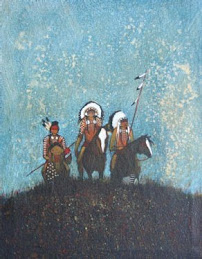
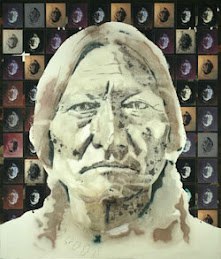
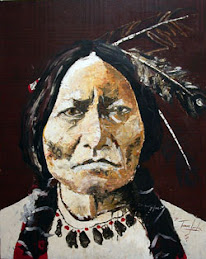
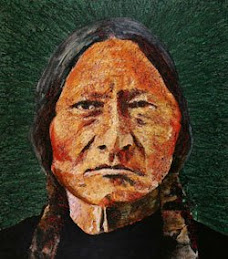

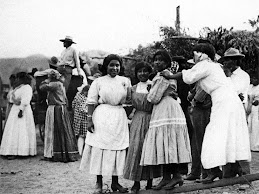





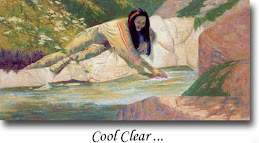

,+Peggy+O%27Neal.jpg)
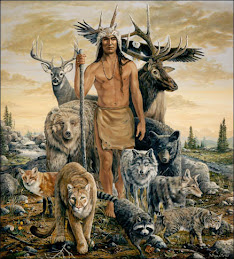,+Peggy+O%27Neal.jpg)
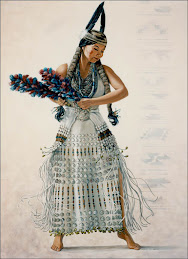,+Peggy+O%27Neal.jpg)
,+Peggy+O%27Neal.jpg)






